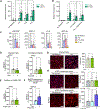Fusobacterium nucleatum induces proliferation and migration in pancreatic cancer cells through host autocrine and paracrine signaling
- PMID: 36256708
- PMCID: PMC9732933
- DOI: 10.1126/scisignal.abn4948
Fusobacterium nucleatum induces proliferation and migration in pancreatic cancer cells through host autocrine and paracrine signaling
Abstract
The tumor microbiome is increasingly implicated in cancer progression and resistance to chemotherapy. In pancreatic ductal adenocarcinoma (PDAC), high intratumoral loads of Fusobacterium nucleatum correlate with shorter survival in patients. Here, we investigated the potential mechanisms underlying this association. We found that F. nucleatum infection induced both normal pancreatic epithelial cells and PDAC cells to secrete increased amounts of the cytokines GM-CSF, CXCL1, IL-8, and MIP-3α. These cytokines increased proliferation, migration, and invasive cell motility in both infected and noninfected PDAC cells but not in noncancerous pancreatic epithelial cells, suggesting autocrine and paracrine signaling to PDAC cells. This phenomenon occurred in response to Fusobacterium infection regardless of the strain and in the absence of immune and other stromal cells. Blocking GM-CSF signaling markedly limited proliferative gains after infection. Thus, F. nucleatum infection in the pancreas elicits cytokine secretion from both normal and cancerous cells that promotes phenotypes in PDAC cells associated with tumor progression. The findings support the importance of exploring host-microbe interactions in pancreatic cancer to guide future therapeutic interventions.
Figures







Similar articles
-
Intratumor Fusobacterium nucleatum promotes the progression of pancreatic cancer via the CXCL1-CXCR2 axis.Cancer Sci. 2023 Sep;114(9):3666-3678. doi: 10.1111/cas.15901. Epub 2023 Jul 12. Cancer Sci. 2023. PMID: 37438965 Free PMC article.
-
Pancreatic Ductal Adenocarcinoma (PDAC) circulating tumor cells influence myeloid cell differentiation to support their survival and immunoresistance in portal vein circulation.PLoS One. 2022 Mar 22;17(3):e0265725. doi: 10.1371/journal.pone.0265725. eCollection 2022. PLoS One. 2022. PMID: 35316296 Free PMC article.
-
Interleukin 35 Expression Correlates With Microvessel Density in Pancreatic Ductal Adenocarcinoma, Recruits Monocytes, and Promotes Growth and Angiogenesis of Xenograft Tumors in Mice.Gastroenterology. 2018 Feb;154(3):675-688. doi: 10.1053/j.gastro.2017.09.039. Epub 2017 Oct 6. Gastroenterology. 2018. PMID: 28989066
-
Intratumoral Fusobacterium nucleatum in Pancreatic Cancer: Current and Future Perspectives.Pathogens. 2024 Dec 26;14(1):2. doi: 10.3390/pathogens14010002. Pathogens. 2024. PMID: 39860963 Free PMC article. Review.
-
Pancreatic stellate cells and pancreas cancer: current perspectives and future strategies.Eur J Cancer. 2014 Oct;50(15):2570-82. doi: 10.1016/j.ejca.2014.06.021. Epub 2014 Aug 1. Eur J Cancer. 2014. PMID: 25091797 Review.
Cited by
-
A case of resected anaplastic carcinoma of the pancreas producing granulocyte-colony stimulating factor with literature review.Surg Case Rep. 2024 Sep 5;10(1):205. doi: 10.1186/s40792-024-02008-3. Surg Case Rep. 2024. PMID: 39231851 Free PMC article.
-
Establishment and improvement of genetic manipulation tools for Fusobacterium nucleatum.Eng Microbiol. 2025 Feb 8;5(1):100192. doi: 10.1016/j.engmic.2025.100192. eCollection 2025 Mar. Eng Microbiol. 2025. PMID: 40538714 Free PMC article. Review.
-
Roles of microbiota in pancreatic cancer development and treatment.Gut Microbes. 2024 Jan-Dec;16(1):2320280. doi: 10.1080/19490976.2024.2320280. Epub 2024 Feb 27. Gut Microbes. 2024. PMID: 38411395 Free PMC article. Review.
-
IPIAD- an augmentation regimen added to standard treatment of pancreatic ductal adenocarcinoma using already-marketed repurposed drugs irbesartan, pyrimethamine, itraconazole, azithromycin, and dapsone.Oncoscience. 2024 Feb 7;11:15-31. doi: 10.18632/oncoscience.594. eCollection 2024. Oncoscience. 2024. PMID: 38524376 Free PMC article.
-
The role of oral microbiota in cancer.Front Microbiol. 2023 Oct 24;14:1253025. doi: 10.3389/fmicb.2023.1253025. eCollection 2023. Front Microbiol. 2023. PMID: 37954233 Free PMC article. Review.
References
-
- Buscail L, Bournet B & Cordelier P Role of oncogenic KRAS in the diagnosis, prognosis and treatment of pancreatic cancer. Nat. Rev. Gastroenterol. Hepatol 17, 153–168 (2020). - PubMed
Publication types
MeSH terms
Substances
Grants and funding
LinkOut - more resources
Full Text Sources
Medical

